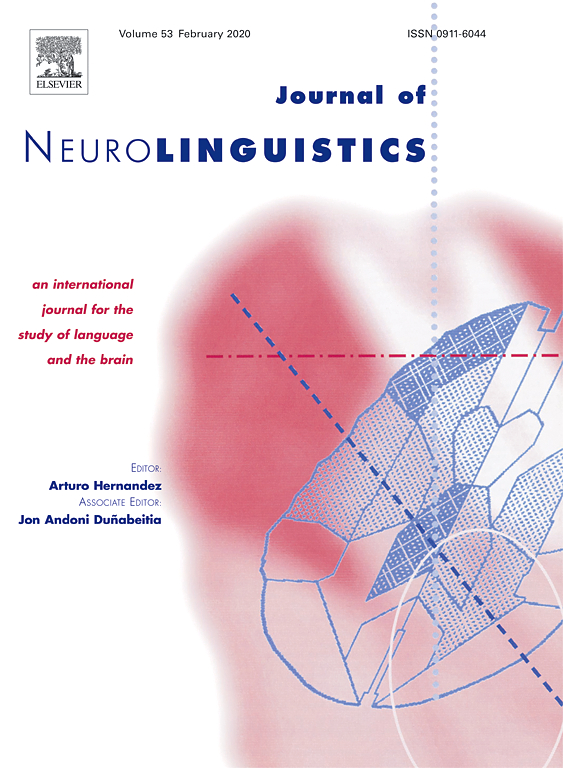【限时资源,期刊全文】Journal of Neurolinguistics《神经语言学杂志》2019年论文集-共76篇论文(侵删)
1192 阅读 14 下载 2020-06-24 18:14:03 上传 62.49 MB
本期推送的是SSCI期刊——Journal of Neurolinguistics《神经语言学杂志》2019年论文集、即第49-52卷共76篇论文,其中目录可在正文中查看,全文可以点击文末附件列表下载,下载链接即日起三天内有效
Journal of Neurolinguistics《神经语言学杂志》2019年论文集-共76篇论文(侵删)
资料整理:张明辉(微信:zhangxiaojian160408)
(下载链接三天内有效,失效后请联系小编微信索取)

| 卷号 | 论文号 | 论文题目 |
| Vol. 49 | Article 01 | Profile of hyperlexia: Reconciling conflicts through a systematic review and meta-analysis |
| Vol. 49 | Article 02 | Factive and counterfactive interpretation of embedded clauses in aphasia and its relationship with lexical, syntactic and general cognitive capacities |
| Vol. 49 | Article 03 | What can repetition, reading and naming tell us about Jargon aphasia? |
| Vol. 49 | Article 04 | Metaphorical meaning learning in contexts: An event-related potential study |
| Vol. 49 | Article 05 | On the neural basis of word reading: A meta-analysis of fMRI evidence using activation likelihood estimation |
| Vol. 49 | Article 06 | Are there similarities between emotional and familiarity-based processing in visual word recognition? |
| Vol. 49 | Article 07 | Differential effect of reading training on functional connectivity in children with reading difficulties with and without ADHD comorbidity |
| Vol. 49 | Article 08 | Differential effects of negative and positive emotional content over veridical and false recognition in aging and Alzheimer's disease |
| Vol. 49 | Article 09 | Bilingual aphasia: Explanations in population encoding |
| Vol. 49 | Article 10 | Brain electrophysiological responses to emotion nouns versus emotionless nouns |
| Vol. 49 | Article 11 | The cognitive and neural oscillatory mechanisms underlying the facilitating effect of rhythm regularity on speech comprehension |
| Vol. 49 | Article 12 | Effects of morphological complexity in left temporal cortex: An MEG study of reading Chinese disyllabic words |
| Vol. 49 | Article 13 | Episodic future thinking and narrative discourse generation in children with Autism Spectrum Disorders |
| Vol. 49 | Article 14 | Bi-lateralized Whorfian effect in color perception: Evidence from Chinese Sign Language |
| Vol. 49 | Article 15 | Chinese phonological consistency effect in native and second language learners of Chinese: An fMRI study |
| Vol. 49 | Article 16 | Neuroemergentism: A framework for studying cognition and the brain |
| Vol. 49 | Article 17 | It's about time: Adding processing to neuroemergentism |
| Vol. 49 | Article 18 | Emergent and constrained: Understanding brain and cognitive development |
| Vol. 49 | Article 19 | Neuroemergentism: Levels and constraints |
| Vol. 49 | Article 20 | What underlies the emergence of stimulus- and domain-specific neural responses? Commentary on Hernandez, Claussenius-Kalman, Ronderos, Castilla-Earls, Sun, Weiss, & Young (2018) |
| Vol. 49 | Article 21 | Emergentism in neuroscience and beyond |
| Vol. 49 | Article 22 | The compatibility within a modular framework of emergent and dynamical processes in mind and brain |
| Vol. 49 | Article 23 | If experience is not enough: Understanding multilingualism through early neurobiological variability |
| Vol. 49 | Article 24 | Commentary on Neuroemergentism: A framework for studying cognition and the brain. The neurocomputations of neuroemergentism: Long-term memory + reinforcement learning = language? |
| Vol. 49 | Article 25 | Neuroemergentism: At the intersection of ontogeny and phylogeny |
| Vol. 49 | Article 26 | Tracking qualitative changes in cognition and brain development through bilingualism |
| Vol. 49 | Article 27 | Neuroemergentism: Response to commentaries |
| Vol. 50 | Article 28 | Cross-linguistic perspectives on second language reading |
| Vol. 50 | Article 29 | Neurobiological signatures of L2 proficiency: Evidence from a bi-directional cross-linguistic study |
| Vol. 50 | Article 30 | What is phonological awareness in L2? |
| Vol. 50 | Article 31 | Beyond the simple view of early first and second language reading: The impact of lexical quality |
| Vol. 50 | Article 32 | How Dutch and Turkish-Dutch readers process morphologically complex words: An ERP study |
| Vol. 50 | Article 33 | Neuroimaging evidence for sensitivity to orthography-to-phonology conversion in native readers and foreign learners of Chinese |
| Vol. 50 | Article 34 | Radical repetition effects in beginning learners of Chinese as a foreign language reading |
| Vol. 50 | Article 35 | Another look at the role of vowel letters in word reading in L2 English among native Korean readers |
| Vol. 50 | Article 36 | Reading comprehension in L1 and L2: An integrative approach |
| Vol. 50 | Article 37 | Situation model building ability uniquely predicts first and second language reading comprehension |
| Vol. 50 | Article 38 | Do adults acquire a second orthography using their native reading network? |
| Vol. 50 | Article 39 | Chinese-English bilinguals transfer L1 lexical reading procedures and holistic orthographic coding to L2 English |
| Vol. 50 | Article 40 | Deconstructing and reconstructing cross-language transfer in bilingual reading development: An interactive framework |
| Vol. 51 | Article 41 | The second-order effect of orthography-to-phonology mapping consistency on Chinese spoken word recognition |
| Vol. 51 | Article 42 | Neural correlates of intra-sentential code-switching in the auditory modality |
| Vol. 51 | Article 43 | The influence of bilingual language experience on executive control: An ERPs study |
| Vol. 51 | Article 44 | The impact of the Cognitive Pragmatic Treatment on the pragmatic and informative skills of individuals with traumatic brain injury (TBI) |
| Vol. 51 | Article 45 | Does phonological rule of tone substitution modulate mismatch negativity? |
| Vol. 51 | Article 46 | Brain responses to morphologically complex verbs: An electrophysiological study of Swedish regular and irregular past tense forms |
| Vol. 51 | Article 47 | Changes in the functional connectivity of auditory and language-related brain regions in children with congenital severe sensorineural hearing loss: An fMRI study |
| Vol. 51 | Article 48 | Backward licensing of Negative Polarity Items in Dutch: An ERP investigation |
| Vol. 51 | Article 49 | Neural correlates of processing emotions in words across cultures |
| Vol. 51 | Article 50 | Altered hemispheric specialization for speech in adult dyslexic readers: An ERPs and dichotic listening study |
| Vol. 51 | Article 51 | Prosodic phrase priming during listening to Chinese ambiguous phrases in different experimental tasks |
| Vol. 51 | Article 52 | An electrophysiological investigation of translation and morphological priming in biscriptal bilinguals |
| Vol. 51 | Article 53 | Right hemisphere involvement for pun processing – Effects of idiom decomposition |
| Vol. 51 | Article 54 | The fundamental phonological unit of Japanese word production: An EEG study using the picture-word interference paradigm |
| Vol. 51 | Article 55 | Levodopa effect on spontaneous speech in Parkinson's disease |
| Vol. 51 | Article 56 | Brain activation and functional connectivity during Chinese writing: An fMRI study |
| Vol. 51 | Article 57 | Higher resting state functional connectivity between the vmPFC and rTPJ in individuals who display conversational synchrony |
| Vol. 51 | Article 58 | A dissociation between syntactic and lexical processing in Parkinson's disease |
| Vol. 51 | Article 59 | When embeddedness matters: Electrophysiological evidence for the role of head noun position in Chinese relative clause processing |
| Vol. 51 | Article 60 | Speech perception in bilingual contexts: Neuropsychological impact of mixing languages at the inter-sentential level |
| Vol. 51 | Article 61 | Asymmetry of affect in verbal irony understanding: What about the N400 and P600 components? |
| Vol. 51 | Article 62 | The involvement of subcortical grey matter in verbal semantic comprehension: A systematic review and meta-analysis of fMRI and PET studies |
| Vol. 51 | Article 63 | Semantic processing of metaphor: A case-study of deep dyslexia |
| Vol. 51 | Article 64 | Concrete and abstract word processing in deep dyslexia |
| Vol. 52 | Article 65 | Everyday conversation after right hemisphere damage: A methodological demonstration and some preliminary findings |
| Vol. 52 | Article 66 | Processing of non-contrastive subphonemic features in French homophonous utterances: An MMN study |
| Vol. 52 | Article 67 | An elephant needs a head but a horse does not: An ERP study of classifier-noun agreement in Mandarin |
| Vol. 52 | Article 68 | Semantic unification modulates N400 and BOLD signal change in the brain: A simultaneous EEG-fMRI study |
| Vol. 52 | Article 69 | The role of valence and origin of emotions in emotional categorization task for words |
| Vol. 52 | Article 70 | Is Theory of Mind the basis for exhaustivity in wh-questions? Evidence from TOM impairment after right hemisphere damage |
| Vol. 52 | Article 71 | Prosodically controlled derivations in the mental lexicon |
| Vol. 52 | Article 72 | Updating emotional information in daily language comprehension: The influence of topic shifts |
| Vol. 52 | Article 73 | Atypical N170 lateralization of face and word recognition in Chinese children with autism spectrum disorder |
| Vol. 52 | Article 74 | Lesion-aphasia discordance in acute stroke among Bengali-speaking patients: Frequency, pattern, and effect on aphasia recovery |
| Vol. 52 | Article 75 | Prepositions as a hybrid between lexical and functional category: Evidence from an ERP study on German sentence processing |
| Vol. 52 | Article 76 | Messages must be tuned to the target language: Some implications of crosslinguistic semantic diversity for neurolinguistic research on speech production |
所需积分:0 分
限期开放已结束
表情
图片
附件












